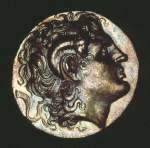
relief sculpture -
A type of sculpture in which
form projects from a background.
There are three degrees or types of relief: high, low, and sunken. In high relief, the forms stand far out from the background. In low relief (best known as bas-relief), they are shallow. In sunken relief, also called hollow or intaglio; the backgrounds are not cut back and the points in highest relief are level with the original surface of the material being carved.
The term sculpto-painting was first used to describe works by Alexander Archipenko (1887-1964), Ukrainian-born Modernist sculptor, who lived and worked in France and the USA. Sculpto-painting was an invention of his World War I years in Nice (1914-1918). The first ones were "polychromed bronzes that combine the properties of painting and relief sculpture like Espanola (Still Life with Head), 1916, a Cubist arrangement of elements carefully patinated in shades of green," said Grace Glueck (contemporary), American art critic, New York Times, April 14, 2005, p. B7.
Examples of relief:
![]()
Assyria, Stone Relief, alabaster, 130 x 73 cm, Near-Eastern Museum,
Berlin.

Babylonia, Walking Lion and the Ishtar-Gate of Babylon, glazed
brick reliefs, 6th century BCE,
Near-Eastern Museum, Berlin.

Greece, Grave stele of a little girl with doves,
c. 450-440 BCE,
Parian marble relief,
height 31 1/2 inches (80
cm), Metropolitan Museum of Art, NY. See Greek art.
![]()
Greece, Athens, c. 400 BCE,
Grave Stele, marble, 40.4 x 17 x 6 inches (102.5
x 43.25 x 15.25 cm), J. Paul Getty Museum, Malibu, CA. See stele.
![]()

Thrace, Tetradrachm of Lysimachos, 323-281 BCE, silver. See numismatics.
Vecchietta (Lorenzo di Piero di Giovanni) (Italian, 1410-1480), The Resurrection, 1472, bronze, height 21 3/8 inches (54.3 cm), width 16 1/4 inches (41.2 cm), Frick Collection, NY. Inscribed on the center panel of the sarcophagus: OPUS.LAUR / ENTII.PETRI.P / ITTORIS.AL / VECHIETTA. / DE ENIS.M. / CCCC.LXXII
Michelangelo Buonarroti (Italian, 1475-1564), The Battle of Lapiths and Centaurs (Centauromachia), 1491-92, marble, 33 1/4 x 35 5/8 inches (84.5 x 90.5 cm), Casa Buonarroti, Florence. See Renaissance.
Alessandro Algardi (Italian, 1598-1654), Pietà, 1630-40, octagonal bronze relief (a rectangular frame conceals corners), excluding flange: 11 3/4 x 11 3/4 inches (29.8 x 29.8 cm), Frick Collection, NY. See Pietà.
Paul Gauguin (French, 1848-1903), Forest of the House of Joy, 1902, bas-relief, paint on sequoia wood, Musée d'Orsay, Paris.
Augustus Saint-Gaudens (American, 1848-1907), Amor Caritas, 1880-98, this cast 1918, gilded-bronze relief, Metropolitan Museum of Art, NY.
Augustus Saint-Gaudens, Samuel G. Ward, 1881, bronze, Metropolitan Museum of Art, NY.

Augustus Saint-Gaudens, Robert Gould Shaw and the 54th Regiment Memorial,
1897-1900, high relief in patinated
plaster,
National Gallery, Washington, DC. The subject of this sculpture
is also that of the movie Glory [link to a still from the movie]
(Edward Zwick, 1989).
Henri Matisse (French, 1869-1954), Back III, 1916-1917, bas-relief in bronze, 185 x 111.5 x 22.5 cm, Centre Georges Pompidou, Paris.

Pablo Picasso (Spanish, 1881-1973), Still Life, 1914, painted wood
and upholstery fringe, relief, 25.4 x 45.7
x 9.2 cm, Tate Gallery, London.

Ben Nicholson, OM (English, 1894-1982), 1934 (relief), 1934, oil
on wood, relief, 71.8 x 96.5
x 3.2 cm, Tate Gallery, London.

Charles Biederman (American, 1906-2004), Structurist Relief, Red Wing No. 20,
1954-65, oil on metal,
104.8 x 14.9 cm, Tate Gallery, London. See geometric
and Structurist.

Mary Martin (English, 1907-1969), Black Relief, 1957-c. 1966, painted wood, board and plastic
relief, 76.4 x 114.0 x 14.8 cm, Tate Gallery, London. See feminism and feminist art.

Roy Lichtenstein (American, 1923-1997), Wall Explosion II, 1965, enamel on steel
relief, 170.2 x 188.0 x 10.2 cm, 110 kg, Tate Gallery, London.
Lichtenstein's cartoon-style explosion displays a type of
balance called radial
symmetry. See benday
and Pop Art.

Mark Boyle (English, 1934-), Holland Park Avenue Study, 1967, relief, 238.8 x 238.8 x 11.4 cm, Tate
Gallery, London.
Charles Ray (American, contemporary), Bath, 1989, porcelain bathtub, brass, aluminum and water, 60 x 29 1/2 x 21 inches, Museum of Contemporary Art, Los Angeles.
To see more easily accessible
examples of relief, just look at the coins in your pocket or purse!
Also see bas-relief, dent, frieze, grisaille, high relief, intaglio, medal, misericord, numismatics, plaque, repoussé, Romanesque, shadow, and tympanum.
https://inform.quest/_art